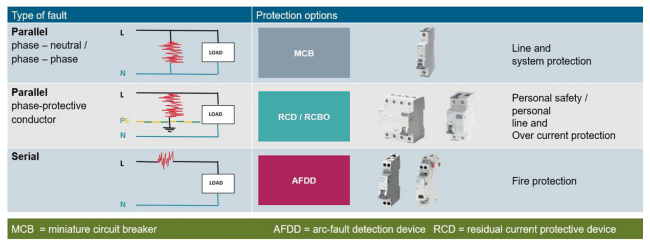Closing the safety Gap with Arc Fault Detection Devices (AFDDs)
Arc faults mostly appear gradually and in low-voltage installations which makes them virtually impossible to detect. They are a used due to broken, crushed or damaged cables and wires, as well as loose contact points and damaged insulation.
Protective devices may NOT prevent Arc Faults
Electric Arc Faults cannot be detected by common protective devices. The MCB and RCCB devices guard against overloads, leakage currents and short circuits. But, they are unable to detect underlying fault which causes majority of short circuits and fire incidents: Arc faults. Many times, the rating of MCB devices is higher than the voltage which paves the way for Arc faults.
Arc faults can steadily increase the temperatures within the cables to damage insulation and cause short circuit, which ultimately leads to fire.
INTERNATIONAL STANDARDS
A number of International Standards are in place to help avoid electrical fire incidents and make electrical devices safer for use, and they propose using of Arc fault detection devices. For example, the standard IEC 60364-4-42 regulates safety aspects of installation of electrical devices in residential buildings. The standard addresses issues of protection against thermal defects.
Relevant Standards in India:
- IS 732 Code of Practice for Electrical Wiring Installations 4.1.2.3
- Protection against thermal effects
- IS 17121 General requirements for arc fault detection devices

The AFDD is now enabled to provide integrated protection from overcurrent, short circuit as well as the serial arcing fault. Only one device can now offer personal protection, line protection as well as overcurrent protection. Thus, the AFDD ensure both safety of person and property as well maintaining the availability of electrical system. AFDD offers protection from
AFDD OFFERS PROTECTION FROM
- Overload (1.45 times rated current)
- Short circuit (5 times rated current)
- Earth leakage ( 30 mA/100 mA/300 mA)
- Arc faults (>2A rated current )
- Overvoltage (275 volts)
Working Principle of AFDDs
AFDD possesses high-frequency sensors and current sensors, which enables it to measure the high frequency line noise emanating from sinusoidal wave. The microcontroller evaluates different algorithms and accordingly send a tripping signal leading to tripping.

Application of AFDD
It is recommended to use AFDDs in following high risk establishments:
- Hospital Buildings
- Educational Institutes
- Hotels
- High Rise Residential Buildings
- Commercial Establishments, Malls etc.
Roles of Wires & Cables
The size and length of the cable along with the quality of conductor and insulation has a definite role to play in prevention of Arc Faults. Copper being an excellent conductor, resists overheating thus keeping the insulation intact. This arrest the primary cause of Arc faults. Adhering to the standards, use of quality conductor along with AFDDs makes the circuit electrically safe.


